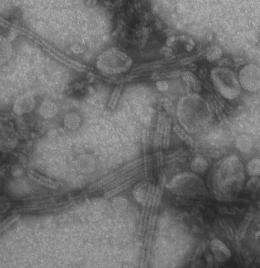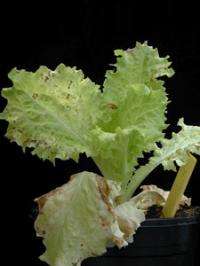New DNA equipment reveals risk of so-called symptom-free lettuce big vein associated virus

Plant Research International, part of Wageningen UR, has used its next generation sequencing DNA equipment to show that it is the Lettuce big vein associated virus (LBVaV) itself that causes necrotic symptoms in lettuce. For years it was assumed that the virus was present in lettuce without showing any symptoms. Thanks to this new knowledge about the true nature of the virus, breeding companies can better address the risks of the virus.
LBVaV always occurs in a complex with other viruses that cause the lettuce big vein and lettuce ring necrosis diseases. The saleability of lettuce is considerably reduced when lettuce leaves show necrotic rings and spots.
Which virus is responsible?
There are two main soil-transmitted diseases in lettuce: Lettuce big vein and Lettuce ring necrosis. Both diseases are caused by viruses in the Ophiovirus genus: The Mirafiori lettuce big-vein virus, or MiLBVV, and the Lettuce ring necrosis virus, or LRNV.
The Lettuce big vein associated virus, LBVaV, is almost always present at the same time as the other two viruses. As the absence of the LBVaV virus did not change anything in the symptoms caused by the other two viruses, it was assumed that LBVaV did not cause any symptoms itself. In some cases, however, there were necrosis symptoms in lettuce that was only infected by MiLBVV and LBVaV (and not LRNV). Scientists from Plant Research International therefore studied the possible involvement of LBVaV in these symptoms.

Difficult to study
LBVaV is a highly unstable virus that is very difficult to isolate from plants, and therefore very difficult to study individually. Martin Verbeek, plant virologist at Plant Research International, managed to isolate the virus from the complex with the other known lettuce viruses using new inoculation technologies, and then multiply it individually in indicator plants. The virus was subsequently transferred into healthy lettuce, which then became diseased. The plants showed a syndrome with necrotic rings and spots. It was, however, impossible to rule out that other unknown viruses were involved in causing the necrotic symptoms.
Next generation sequencing
The proof that LBVaV was the cause of the necrotic symptoms was found by using next generation sequencing DNA equipment, which can screen plants for genetic material from viruses at a DNA level within a short time period. It can even help uncover ‘hidden’ viruses. In the LBVaV-infected lettuce plants with necrotic symptoms, the only virus found was the LBVaV-RNA. Genetic material from other viruses was not present. This proves that LBVaV does indeed cause symptoms, and therefore affects the saleability of lettuce.
Next generation sequencing has proven to be an excellent tool for discovering the actual characteristics of a virus previously assumed to do very little harm. It is the first example in which the very latest molecular technology has been successfully linked to the gold standard from the 19th century, ‘Koch’s postulates’.
More information: Article ‘Evidence for Lettuce big-vein associated virus as the causal agent of a syndrome of necrotic rings and spots in lettuce’ Plant Pathology, Doi: 10.1111/j.1365-3059.2012.02645.x
Provided by Wageningen University

















